人教版(2019)必修 第一册Unit5 Languages around the World Reading and Thinking课件(共29张PPT)
文档属性
| 名称 | 人教版(2019)必修 第一册Unit5 Languages around the World Reading and Thinking课件(共29张PPT) | 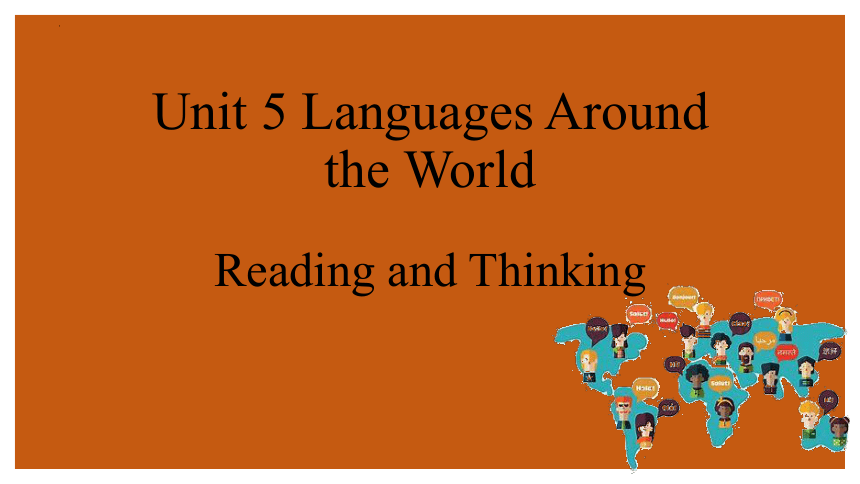 | |
| 格式 | pptx | ||
| 文件大小 | 3.4MB | ||
| 资源类型 | 教案 | ||
| 版本资源 | 人教版(2019) | ||
| 科目 | 英语 | ||
| 更新时间 | 2024-04-16 17:58:19 | ||
图片预览

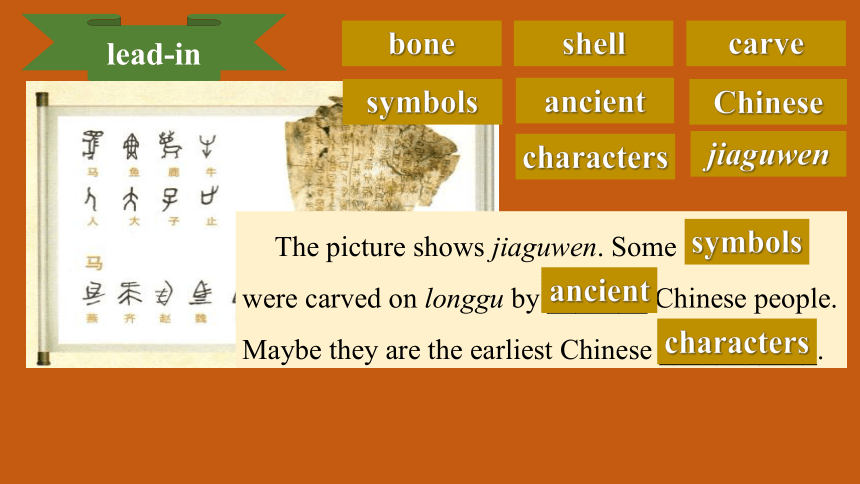

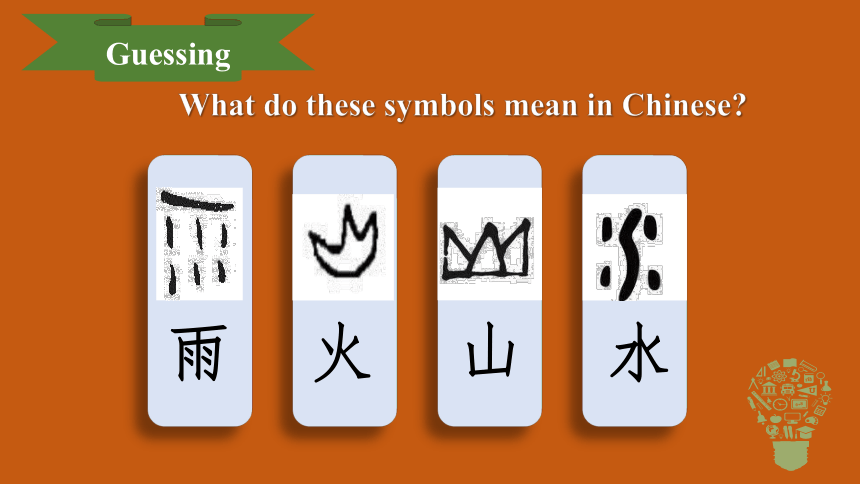
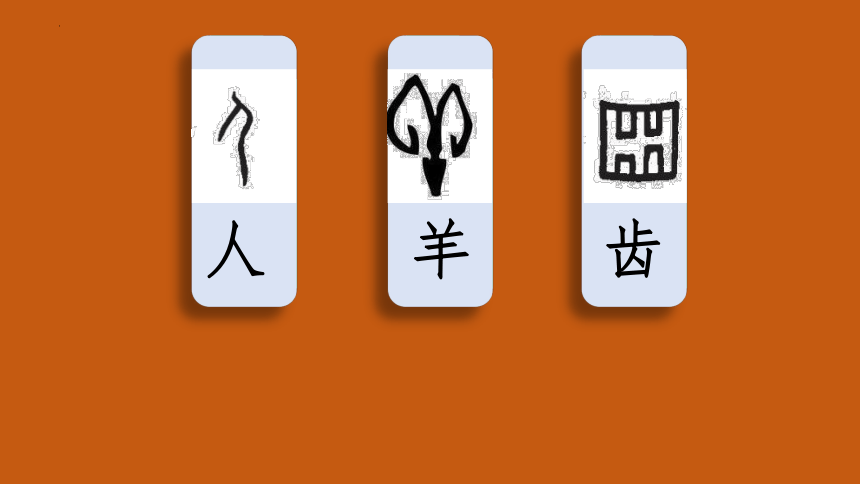

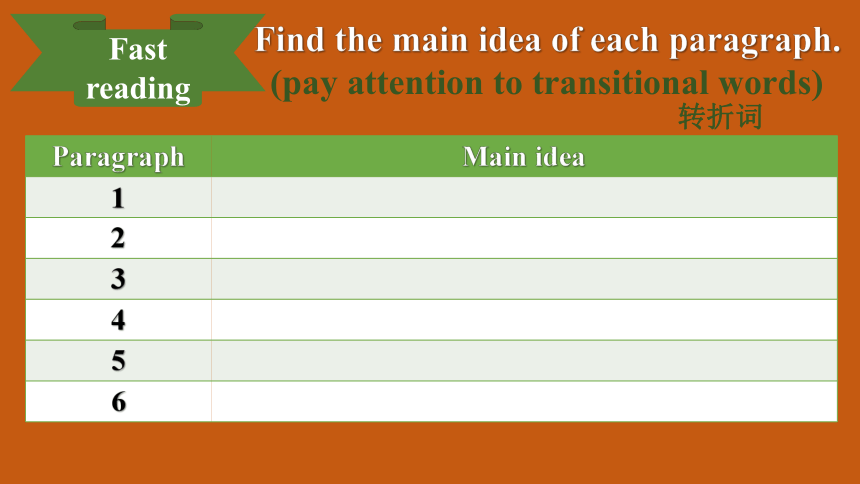
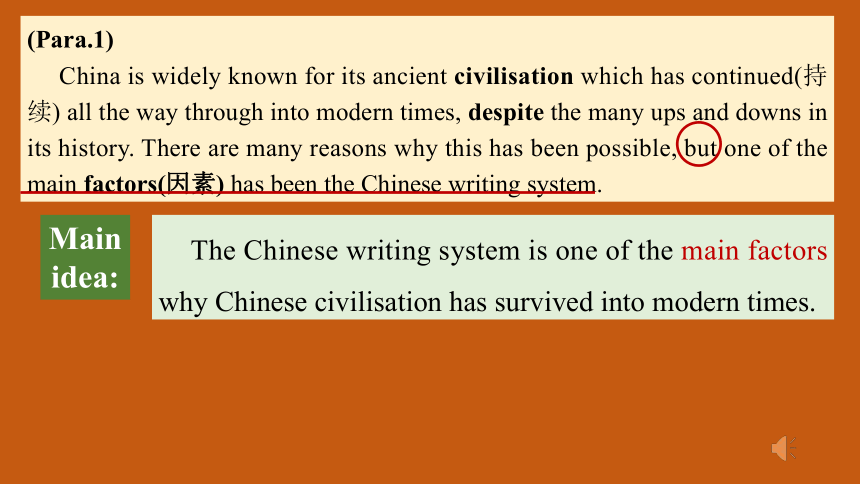
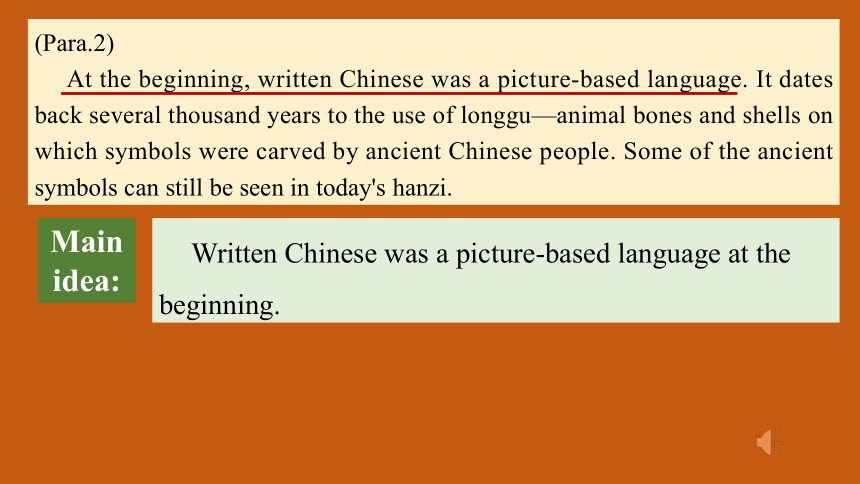
文档简介
(共29张PPT)
Unit 5 Languages Around the World
Reading and Thinking
lead-in
symbols
ancient
Chinese
characters
carve
bone
shell
jiaguwen
The picture shows jiaguwen. Some _______ were carved on longgu by _______ Chinese people. Maybe they are the earliest Chinese ___________.
symbols
ancient
characters
Explore the Chinese writing system.
What do these symbols mean in Chinese
雨
火
山
水
Guessing
人
羊
齿
Prediction
about the picture
about the title
The Chinese Writing System:
Connecting the Past and the Present
Chinese characters
topic
focus
连接
Fast reading
Find the main idea of each paragraph.
(pay attention to transitional words)
转折词
Paragraph Main idea
1
2
3
4
5
6
(Para.1)
China is widely known for its ancient civilisation which has continued(持续) all the way through into modern times, despite the many ups and downs in its history. There are many reasons why this has been possible, but one of the main factors(因素) has been the Chinese writing system.
Main idea:
The Chinese writing system is one of the main factors why Chinese civilisation has survived into modern times.
(Para.2)
At the beginning, written Chinese was a picture-based language. It dates back several thousand years to the use of longgu—animal bones and shells on which symbols were carved by ancient Chinese people. Some of the ancient symbols can still be seen in today's hanzi.
Main idea:
Written Chinese was a picture-based language at the beginning.
(Para.3)
By the Shang Dynasty (around 1600-1046 BCE), these symbols had become a well-developed writing system. Over the years, the system developed into different forms(形式), as it was a time when people were divided geographically, leading to many varieties of dialects and characters. This, however, changed under Emperor Qinshihuang of the Qin Dynasty (221-207 BCE).
Main idea:
The writing system became well-developed, and later developed into different forms.
(Para.4)
Emperor Qinshihuang united united the seven major states into one unified country where the Chinese writing system began to develop in one direction. That writing system was of great importance in uniting the Chinese people and culture. Even today, no matter where Chinese people live or what dialect they speak, they can all still communicate in writing.
Main idea:
The Chinese writing system began to develop in one direction(方向).
(Para.5)
Written Chinese has also become an important means by which China’s present is connected with its past. People in modern times can read the classic works which were written by Chinese in ancient times. The high regard for the Chinese writing system can be seen in the development of Chinese characters as an art form, known as Chinese calligraphy, which has become an important part of Chinese culture.
Main idea:
Written Chinese connects(连接) China’s present with its past, and has become an art form.
(Para.6)
Today, the Chinese Writing System is still an important part of Chinese culture. As China plays a greater role in global affairs, an increasing number of international students are beginning to appreciate China's culture and history through this amazing language.
Main idea:
The Chinese language is helping to spread(传播) China’s culture and history to the world.
Scanning
(寻读)
Describe the development of Chinese writing system in a time axis(时间轴).
time
several thousand years to the use of Longgu
a picture-based language
the Shang Dynasty
(1600-2046 BCE)
a well-developed writing system
the Qin Dynasty
(221-207 BCE)
developed
in one direction
History
Chinese writing system
The text describes the development of _______________________ throughout(贯穿) thousands of years. The text is organized in _____ order.
Chinese writing system
time
Scan the text to find the sentences explaining how the Chinese writing system is related to Chinses culture.
Sentence 1 …
Sentence 2 …
…
Chinses characters
Chinese culture
(Para.1)
China is widely known for its ancient civilisation which has continued(持续) all the way through into modern times, despite the many ups and downs in its history. There are many reasons why this has been possible, but one of the main factors(因素) has been the Chinese writing system.
(Para.4)
Emperor Qinshihuang united united the seven major states into one unified country where the Chinese writing system began to develop in one direction. That writing system was of great importance in uniting the Chinese people and culture. Even today, no matter where Chinese people live or what dialect they speak, they can all still communicate in writing.
The Chinese writing system contributes to the survival of Chinese culture.
The Chinese writing system plays an important role in uniting Chinese people and culture.
(Para.5)
Written Chinese has also become an important means by which China’s present is connected with its past. People in modern times can read the classic works which were written by Chinese in ancient times. The high regard for the Chinese writing system can be seen in the development of Chinese characters as an art form, known as Chinese calligraphy, which has become an important part of Chinese culture.
(Para.6)
Today, the Chinese Writing System is still an important part of Chinese culture. As China plays a greater role in global affairs, an increasing number of international students are beginning to appreciate China's culture and history through this amazing language.
The Chinese writing system connects the past and present.
The Chinese writing system spreads(传播) Chinese culture.
Para 4
How did written Chinese unify(统一) Chinese people divided(分开) by geography and dialects
It allowed Chinese people, no matter where they lived or what dialect they had, to communicate with each other.
Para 5
2. How does written Chinese connect Chinese people today with those of the past
People in modern times can read the classic works which were written by Chinese in ancient times.
Your own knowledge
3. According to the writer, the Chinese writing system is one factor that has helped the Chinese language and culture survive. What do you think are some of the other factors
Political reason: China has been a unified country ever since Qin Dynasty.
Geographical reason: China is located mostly in great plain(平原), so the communications between areas are active.
The Chinese Writing System: Connecting the Past and the Present
focus
connect
connect
connect
connect
past
present
people
people
language
art
China
world
1
2
3
4
Guess the meaning of the underlined words in the sentences. Then look in the text for the words they are related to.
Many Chinese characters symbolise their meanings, unlike English words which are spelt out according to how they sound.
The basic forms of the English writing system are known as letters.
A unified writing system is considered to be an important part of civilised society.
Learning Chinese calligraphy will increase your appreciation of Chinese culture.
symbol
based
civilisation
appreciate
Language points
(Para.1)
China is widely known for its ancient civilisation which has continued(持续) all the way through into modern times, despite the many ups and downs in its history. There are many reasons why this has been possible, but one of the main factors(因素) has been the Chinese writing system.
civilised
adj. 文明的
civilization
n. 文明
civilise
vt. 使开化; 文明化
主语
this has been possible for the reason时间状语
_______
for _______
why
which
(Para.2)
At the beginning, written Chinese was a picture-based language. It dates back several thousand years to the use of longgu—animal bones and shells on which symbols were carved by ancient Chinese people. Some of the ancient symbols can still be seen in today's hanzi.
based
adj. 以…为基础的
a picture-based
以图形为基础的
symbols were carved on bones and shells 地点状语
on _______
__________
which
where
(Para.3)
By the Shang Dynasty (around 1600-1046 BCE), these symbols had become a well-developed writing system. Over the years, the system developed into different forms(形式), as it was a time when people were divided(分开) geographically, leading to(导致) many varieties of dialects and characters. This, however, changed under Emperor Qinshihuang of the Qin Dynasty (221-207 BCE).
well-developed
adj.发达的;发展良好的
developed
adj.发达的;先进的;成熟的;高度发展的
develop into发展成了……
It is/was a time when这/那是一个……的时期
(Para.4)
Emperor Qinshihuang united the seven major states into one unified country where the Chinese writing system began to develop in one direction(方向). That writing system was of great importance in uniting the Chinese people and culture. Even today, no matter where Chinese people live or what dialect they speak, they can all still communicate in writing.
unite v.团结;统一 unit… into…
unified adj. 统一的
the Chinese writing system began to develop in one direction in the country地点状语
_______
in __________
where
which
(Para.4)
Emperor Qinshihuang united the seven major states into one unified country where the Chinese writing system began to develop in one direction(方向). That writing system was of great importance in uniting the Chinese people and culture. Even today, no matter where Chinese people live or what dialect they speak, they can all still communicate in writing.
= was important
be of + 名词 = be + adj
修饰词:great, little, much, a lot of…
【2020全国卷】The far side of moon is of particular ______ (interesting) to scientists because it has a lot of deep craters(火山口).
The dictionary is ___ great value for English learners.
interest
of
= is valuable
= is interesting
(Para.4)
Emperor Qinshihuang united the seven major states into one unified country where the Chinese writing system began to develop in one direction(方向). That writing system was of great importance in uniting the Chinese people and culture. Even today, no matter where Chinese people live or what dialect they speak, they can all still communicate in writing.
no matter where /when/who/what/how…
引导让步状语从句,“无论……”
= wherever / whenever / whoever / whatever / however…
引导让步状语从句,“无论……”
【2020天津高考】No matter ____ hard I tried, I was always the neglected(被忽视的) one.
how
Unit 5 Languages Around the World
Reading and Thinking
lead-in
symbols
ancient
Chinese
characters
carve
bone
shell
jiaguwen
The picture shows jiaguwen. Some _______ were carved on longgu by _______ Chinese people. Maybe they are the earliest Chinese ___________.
symbols
ancient
characters
Explore the Chinese writing system.
What do these symbols mean in Chinese
雨
火
山
水
Guessing
人
羊
齿
Prediction
about the picture
about the title
The Chinese Writing System:
Connecting the Past and the Present
Chinese characters
topic
focus
连接
Fast reading
Find the main idea of each paragraph.
(pay attention to transitional words)
转折词
Paragraph Main idea
1
2
3
4
5
6
(Para.1)
China is widely known for its ancient civilisation which has continued(持续) all the way through into modern times, despite the many ups and downs in its history. There are many reasons why this has been possible, but one of the main factors(因素) has been the Chinese writing system.
Main idea:
The Chinese writing system is one of the main factors why Chinese civilisation has survived into modern times.
(Para.2)
At the beginning, written Chinese was a picture-based language. It dates back several thousand years to the use of longgu—animal bones and shells on which symbols were carved by ancient Chinese people. Some of the ancient symbols can still be seen in today's hanzi.
Main idea:
Written Chinese was a picture-based language at the beginning.
(Para.3)
By the Shang Dynasty (around 1600-1046 BCE), these symbols had become a well-developed writing system. Over the years, the system developed into different forms(形式), as it was a time when people were divided geographically, leading to many varieties of dialects and characters. This, however, changed under Emperor Qinshihuang of the Qin Dynasty (221-207 BCE).
Main idea:
The writing system became well-developed, and later developed into different forms.
(Para.4)
Emperor Qinshihuang united united the seven major states into one unified country where the Chinese writing system began to develop in one direction. That writing system was of great importance in uniting the Chinese people and culture. Even today, no matter where Chinese people live or what dialect they speak, they can all still communicate in writing.
Main idea:
The Chinese writing system began to develop in one direction(方向).
(Para.5)
Written Chinese has also become an important means by which China’s present is connected with its past. People in modern times can read the classic works which were written by Chinese in ancient times. The high regard for the Chinese writing system can be seen in the development of Chinese characters as an art form, known as Chinese calligraphy, which has become an important part of Chinese culture.
Main idea:
Written Chinese connects(连接) China’s present with its past, and has become an art form.
(Para.6)
Today, the Chinese Writing System is still an important part of Chinese culture. As China plays a greater role in global affairs, an increasing number of international students are beginning to appreciate China's culture and history through this amazing language.
Main idea:
The Chinese language is helping to spread(传播) China’s culture and history to the world.
Scanning
(寻读)
Describe the development of Chinese writing system in a time axis(时间轴).
time
several thousand years to the use of Longgu
a picture-based language
the Shang Dynasty
(1600-2046 BCE)
a well-developed writing system
the Qin Dynasty
(221-207 BCE)
developed
in one direction
History
Chinese writing system
The text describes the development of _______________________ throughout(贯穿) thousands of years. The text is organized in _____ order.
Chinese writing system
time
Scan the text to find the sentences explaining how the Chinese writing system is related to Chinses culture.
Sentence 1 …
Sentence 2 …
…
Chinses characters
Chinese culture
(Para.1)
China is widely known for its ancient civilisation which has continued(持续) all the way through into modern times, despite the many ups and downs in its history. There are many reasons why this has been possible, but one of the main factors(因素) has been the Chinese writing system.
(Para.4)
Emperor Qinshihuang united united the seven major states into one unified country where the Chinese writing system began to develop in one direction. That writing system was of great importance in uniting the Chinese people and culture. Even today, no matter where Chinese people live or what dialect they speak, they can all still communicate in writing.
The Chinese writing system contributes to the survival of Chinese culture.
The Chinese writing system plays an important role in uniting Chinese people and culture.
(Para.5)
Written Chinese has also become an important means by which China’s present is connected with its past. People in modern times can read the classic works which were written by Chinese in ancient times. The high regard for the Chinese writing system can be seen in the development of Chinese characters as an art form, known as Chinese calligraphy, which has become an important part of Chinese culture.
(Para.6)
Today, the Chinese Writing System is still an important part of Chinese culture. As China plays a greater role in global affairs, an increasing number of international students are beginning to appreciate China's culture and history through this amazing language.
The Chinese writing system connects the past and present.
The Chinese writing system spreads(传播) Chinese culture.
Para 4
How did written Chinese unify(统一) Chinese people divided(分开) by geography and dialects
It allowed Chinese people, no matter where they lived or what dialect they had, to communicate with each other.
Para 5
2. How does written Chinese connect Chinese people today with those of the past
People in modern times can read the classic works which were written by Chinese in ancient times.
Your own knowledge
3. According to the writer, the Chinese writing system is one factor that has helped the Chinese language and culture survive. What do you think are some of the other factors
Political reason: China has been a unified country ever since Qin Dynasty.
Geographical reason: China is located mostly in great plain(平原), so the communications between areas are active.
The Chinese Writing System: Connecting the Past and the Present
focus
connect
connect
connect
connect
past
present
people
people
language
art
China
world
1
2
3
4
Guess the meaning of the underlined words in the sentences. Then look in the text for the words they are related to.
Many Chinese characters symbolise their meanings, unlike English words which are spelt out according to how they sound.
The basic forms of the English writing system are known as letters.
A unified writing system is considered to be an important part of civilised society.
Learning Chinese calligraphy will increase your appreciation of Chinese culture.
symbol
based
civilisation
appreciate
Language points
(Para.1)
China is widely known for its ancient civilisation which has continued(持续) all the way through into modern times, despite the many ups and downs in its history. There are many reasons why this has been possible, but one of the main factors(因素) has been the Chinese writing system.
civilised
adj. 文明的
civilization
n. 文明
civilise
vt. 使开化; 文明化
主语
this has been possible for the reason时间状语
_______
for _______
why
which
(Para.2)
At the beginning, written Chinese was a picture-based language. It dates back several thousand years to the use of longgu—animal bones and shells on which symbols were carved by ancient Chinese people. Some of the ancient symbols can still be seen in today's hanzi.
based
adj. 以…为基础的
a picture-based
以图形为基础的
symbols were carved on bones and shells 地点状语
on _______
__________
which
where
(Para.3)
By the Shang Dynasty (around 1600-1046 BCE), these symbols had become a well-developed writing system. Over the years, the system developed into different forms(形式), as it was a time when people were divided(分开) geographically, leading to(导致) many varieties of dialects and characters. This, however, changed under Emperor Qinshihuang of the Qin Dynasty (221-207 BCE).
well-developed
adj.发达的;发展良好的
developed
adj.发达的;先进的;成熟的;高度发展的
develop into发展成了……
It is/was a time when这/那是一个……的时期
(Para.4)
Emperor Qinshihuang united the seven major states into one unified country where the Chinese writing system began to develop in one direction(方向). That writing system was of great importance in uniting the Chinese people and culture. Even today, no matter where Chinese people live or what dialect they speak, they can all still communicate in writing.
unite v.团结;统一 unit… into…
unified adj. 统一的
the Chinese writing system began to develop in one direction in the country地点状语
_______
in __________
where
which
(Para.4)
Emperor Qinshihuang united the seven major states into one unified country where the Chinese writing system began to develop in one direction(方向). That writing system was of great importance in uniting the Chinese people and culture. Even today, no matter where Chinese people live or what dialect they speak, they can all still communicate in writing.
= was important
be of + 名词 = be + adj
修饰词:great, little, much, a lot of…
【2020全国卷】The far side of moon is of particular ______ (interesting) to scientists because it has a lot of deep craters(火山口).
The dictionary is ___ great value for English learners.
interest
of
= is valuable
= is interesting
(Para.4)
Emperor Qinshihuang united the seven major states into one unified country where the Chinese writing system began to develop in one direction(方向). That writing system was of great importance in uniting the Chinese people and culture. Even today, no matter where Chinese people live or what dialect they speak, they can all still communicate in writing.
no matter where /when/who/what/how…
引导让步状语从句,“无论……”
= wherever / whenever / whoever / whatever / however…
引导让步状语从句,“无论……”
【2020天津高考】No matter ____ hard I tried, I was always the neglected(被忽视的) one.
how
